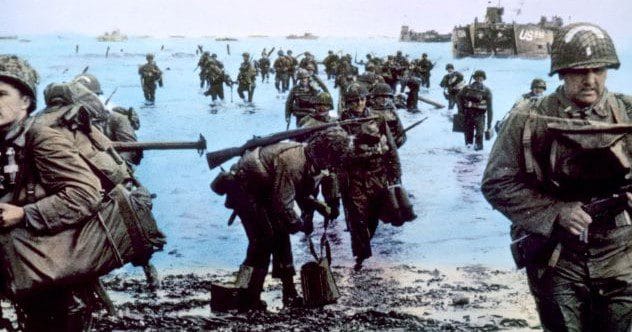On June 6, 1944, the Allied forces launched a massive invasion of Normandy, France, marking the beginning of the end for Nazi Germany. This pivotal moment in World War II, known as D-Day, was a brutal campaign where many Allied soldiers made the ultimate sacrifice. While stories abound about the soldiers storming the beaches, many lesser-known facts add depth to this historic event. Let’s explore ten surprising aspects of D-Day that often go unnoticed.
The Planning Took Years
The seeds of D-Day were sown long before June 1944. Winston Churchill recognized early on the necessity of confronting Hitler’s aggression. As early as October 1941, Churchill discussed with Captain Lord Louis Mountbatten the possibility of a land invasion. By April 1943, Lieutenant-General Sir Frederick Morgan was tasked with preparing British soldiers for a large-scale assault. The Americans joined in December 1943 when President Franklin D. Roosevelt appointed General Dwight D. Eisenhower to command the Allied forces. Eisenhower then began coordinating the Normandy landings. The actual battle was just beginning, but the planning had been underway in secret for nearly three years.[1]
Be a Bigot… Wait, What?
During the planning phase, the term “BIGOT” was used to classify everything related to the operation. This acronym stood for British Invasion of German Occupied Territory. While the spelling might seem unfortunate today, the planners were far more concerned with preventing leaks to the Germans. “BIGOT” became the highest level of classification, even above “Top Secret.” Only the most trusted Allied leaders were allowed access to BIGOT-related documents.
One critical message shared via the BIGOT channel was the last-minute delay. D-Day was initially scheduled for June 5, 1944, but severe weather conditions forced a 24-hour postponement. Allied leaders used the BIGOT network to communicate this crucial change, hoping for better weather on June 6. [2]
Why Is It Called D-Day?
The term “D-Day” was a common military phrase used by the United States and other forces to denote the commencement of an operation. The “D” simply stands for “Day.” While seemingly redundant, it was a standard term for the launch day of any significant military event.
In 1944, it didn’t hold the gravitas it does now. The Allied attack on Normandy was specifically known as Operation Overlord during its planning and execution. It’s only in retrospect that we refer to it primarily as “D-Day,” recognizing the immense sacrifices made by Allied soldiers on that first, brutal day of the invasion.[3]
A Truly Worldwide Affair
While many associate D-Day with soldiers from the United States, Britain, Canada, and France, the Allied forces included a diverse array of nations. Soldiers came from countries like Czechoslovakia, Norway, Greece, Poland, and New Zealand. Even Luxembourg contributed to the effort. Men from Rhodesia (now Zimbabwe) also participated.
This truly global effort was crucial to the Allied success. The combined naval, air, and ground support from numerous nations was essential in pushing back the Nazis. Without this widespread support, the outcome of D-Day and World War II might have been very different.[4]
Hitler Wanted a Wall, Too
Just as the Allies prepared for D-Day, Hitler ordered the construction of the Atlantic Wall along the coasts of France and Western Europe. For years, the Nazis built turrets and defenses stretching nearly 1,700 miles (2,736 kilometers) from Norway to Spain. Hitler envisioned an even longer 2,400-mile (3,862-kilometer) defense line.
Today, remnants of Hitler’s wall still stand, serving as a reminder of the war. These concrete turret defenses and anti-landing obstacles dot the European coastline, offering a glimpse into the past.[5]
Doing the Difficult Thing
Normandy was not the most accessible location for the Allied invasion. The Nazis considered it the least likely spot due to its rocky outcroppings and the distance across the English Channel, plus the lack of port. They anticipated an invasion at Pas de Calais, which had a port and was closer to Great Britain.
The Allies chose Normandy precisely because it was unexpected. They believed it offered a better chance against a less fortified defense. Additionally, Normandy was within range of British air cover. To solve the port problem, the Allies constructed two artificial ports, allowing them to move supplies efficiently. Choosing the difficult location ultimately gave the Allies an advantage.[6]
Faking the News
Before D-Day, the Allies employed “fake news” to mislead Hitler and his forces. Knowing that a single leak could jeopardize the invasion, they launched “Operation Bodyguard,” a campaign of misinformation intended to confuse the Nazis.
For a year leading up to D-Day, the Allies used double agents, fake plans, bogus military camps, and coded radio messages to suggest the invasion would occur elsewhere. On June 6, Allied bombers conducted a high-altitude raid on Calais to reinforce the deception. This strategic use of misinformation helped the Allies gain a crucial advantage. [7]
First by Air… Not by Sea!
The D-Day invasion commenced not with sea landings, but with an air assault. Hours before the beach landings, British and American airborne forces were deployed behind German lines to capture the Caen Canal Bridge, a vital point a few miles inland. Securing this bridge would prevent Nazi reinforcements and supply lines from reaching the beaches.
The 6th British Airborne Division and their American counterparts were tasked with controlling the area around the bridge, ensuring the Allies maintained a strategic advantage. The airborne units succeeded after a difficult ordeal, and the bridge was later renamed Pegasus Bridge in honor of their bravery. These air assaults often go unremembered, even though they were the first actions of the Normandy invasion.[8]
Landing Via Louisiana
A key component of the D-Day landings was the Higgins Boat, designed by Andrew Higgins from Louisiana. Higgins, originally in the lumber business, created these boats to navigate the swampy backwoods of Louisiana. His boats were capable of operating in shallow waters, making them perfect for beach landings.
Initially, Higgins struggled to sell his boats, but the U.S. government recognized their potential for wartime use and ordered 20,000 of them. Known as Landing Craft Vehicle and Personnel ships, these boats were essential in both European and Pacific theaters. They allowed the Navy to land troops and supplies on open beaches, bypassing heavily fortified ports, and changing the dynamics of the war. [9]
Anne Frank Celebrated It
News of the Normandy invasion reached Anne Frank and her family, who were hiding in an Amsterdam attic to escape Nazi persecution. On June 6, they heard a BBC radio report announcing the D-Day landings.
Anne wrote in her diary, expressing hope for liberation. “Is this really the beginning of the long-awaited liberation?” she wondered. While she knew liberation wouldn’t be immediate, the Allied offensive boosted her courage. Tragically, Anne and her family were discovered by the Nazis almost two months later, and she died in 1945 before liberation. Her story underscores the profound impact of D-Day, even on those hidden from the world. [10]
D-Day was a watershed moment in World War II, far more complex and multifaceted than commonly understood. From the extensive planning and global collaboration to the innovative tactics and the widespread hope it inspired, these lesser-known facts offer a deeper appreciation for the sacrifices and strategies that shaped this pivotal event.
Share your thoughts and reflections on these D-Day facts below!










